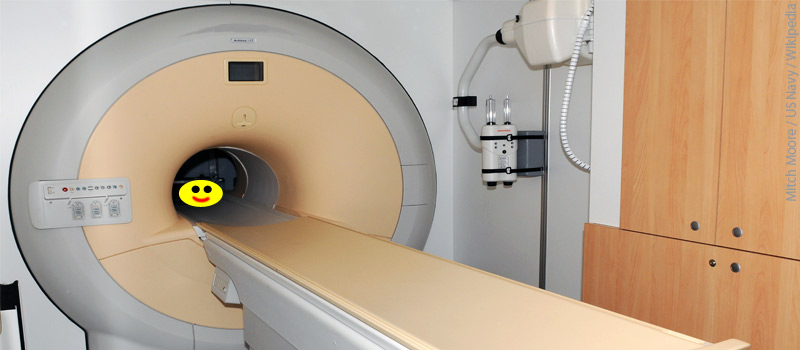
We will discuss the following aspects. Please scroll down and start reading.
- It is all about water: the hydrogen nuclei
- The strange world of quantum physics and spin
- Detection of hydrogen nuclei
- How the MRI machine is able to target different areas of the body
- Receiver coils
- Magnet and Quenching
- Noise: The ” Gradient Coil Guitar “
- Anesthesia and MRI
Magnetic Resonance Imaging (MRI) is a wonderful tool that lets you see inside the body with amazing clarity. The best part is that it does this with no harmful radiation. Unfortunately, the physics concepts related to MRI are complex and mysterious and I do not have enough brain power to fully understand it. Nevertheless, hopefully, my explanations will give you a good starting point to understand this exciting technology.
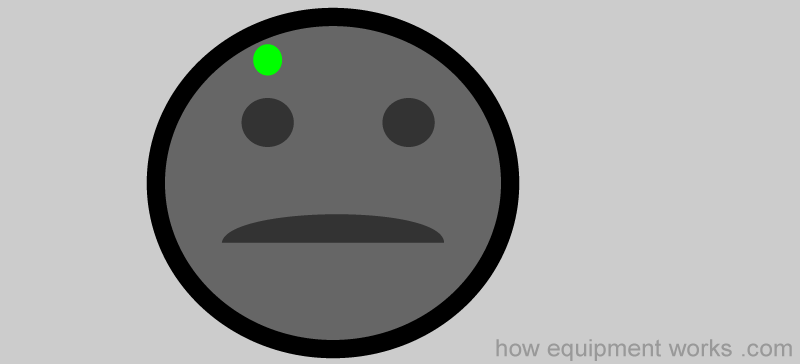
However, if you are an imaging professional, I am sorry to say that my explanations will be too basic for you, and I would advise you to read much more detailed material elsewhere (Good Luck !).
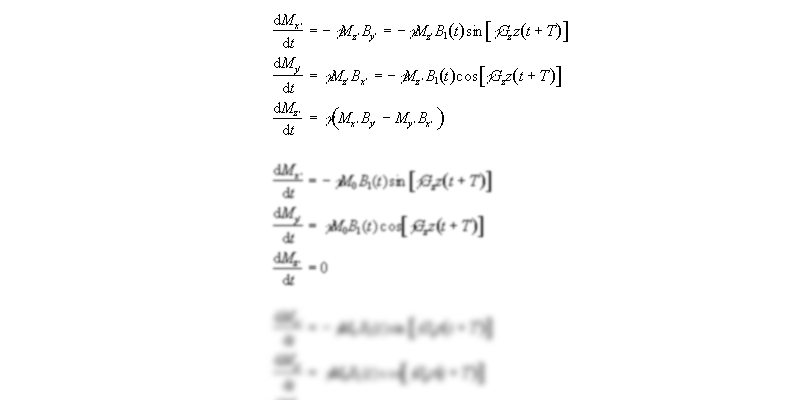
It is all about water (the hydrogen nuclei)!
The MRI machine is able to “see “water and this makes it a very useful tool as we humans are mostly made out of water (about 70 %). Water is distributed throughout our body in different ways and the MRI machine is able to see these differences and construct an image for us.
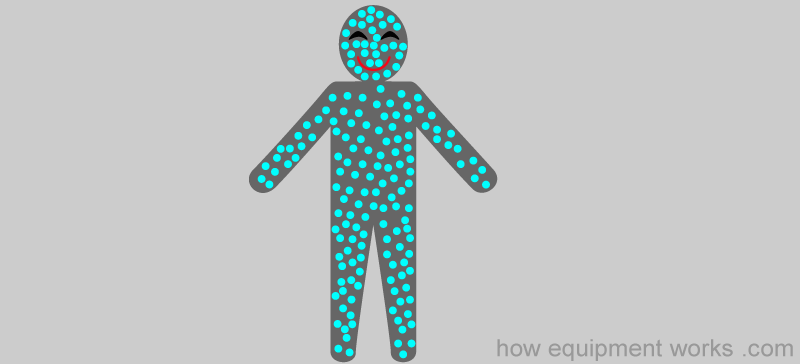
As you probably know, water consists of water molecules. A water molecule is made up of two hydrogen atoms and one oxygen atom.
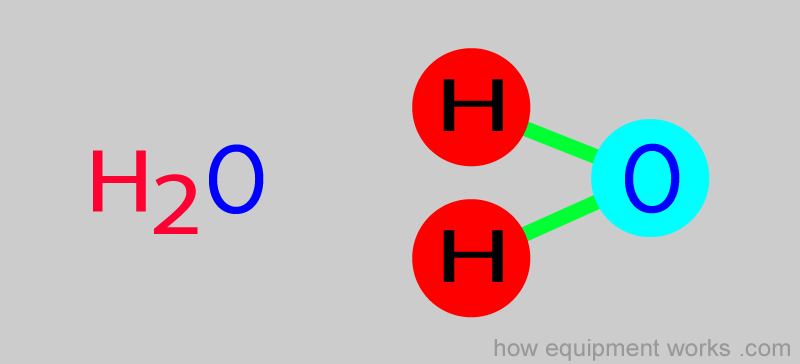
The MRI machine does not “see “all parts of the water molecules. Instead, it sees only specific parts of each water molecule. Let me explain. The diagram below shows some water molecules.
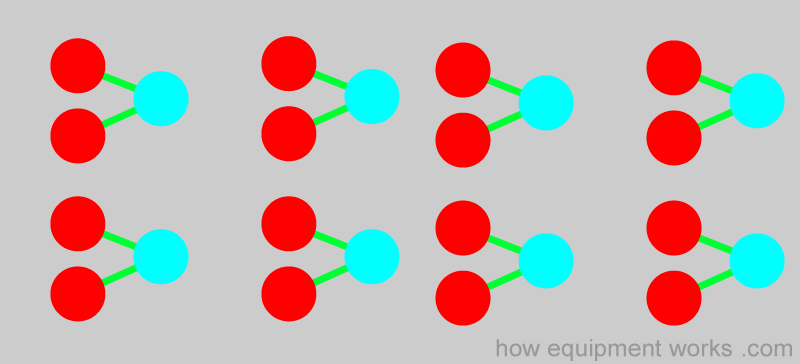
The MRI machine can not see the oxygen atoms of the water molecules, so let us ignore them. What you have left are the hydrogen atoms shown in red below.
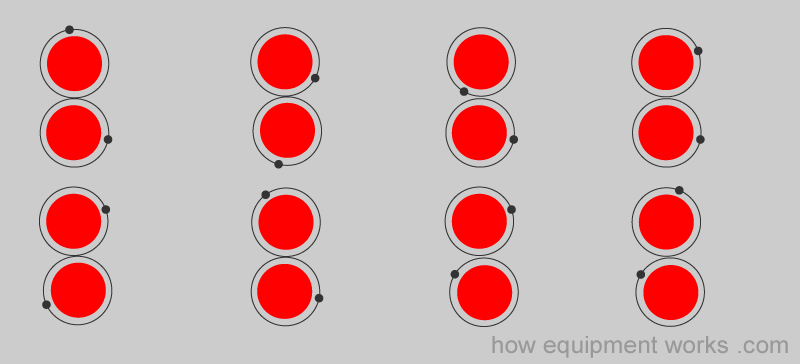
Each hydrogen atom consists of a nucleus with one electron going around it. The MRI machine doesn’t “see” these electrons either.
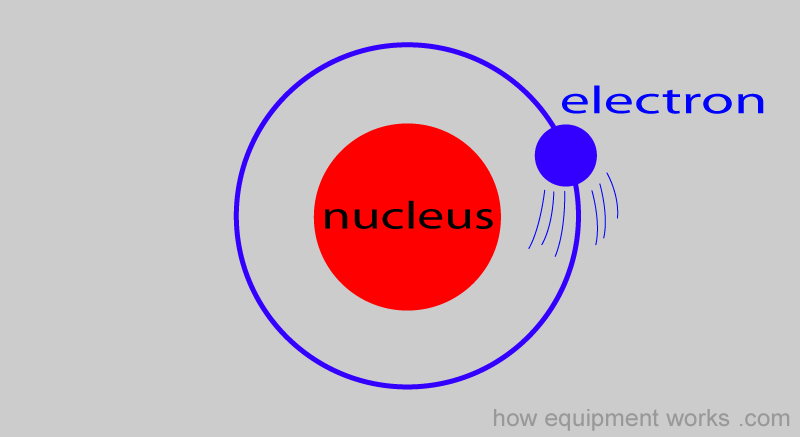
All it sees is the hydrogen nucleus.
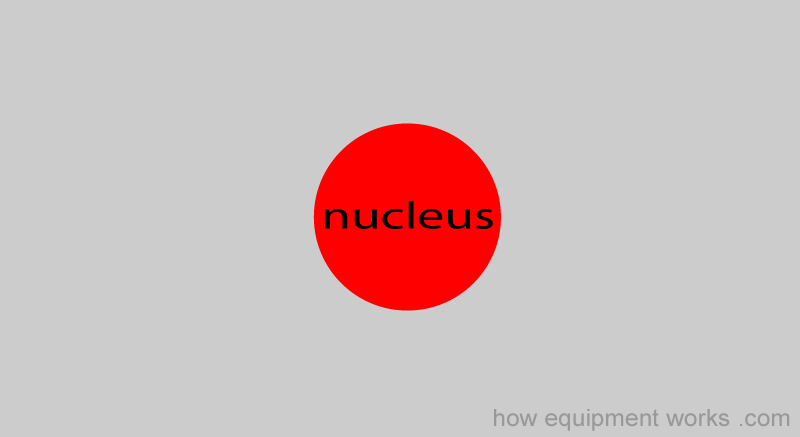
To summarise, regarding water molecules, the MRI machine does not see the oxygen atoms or the electrons of the hydrogen atoms.
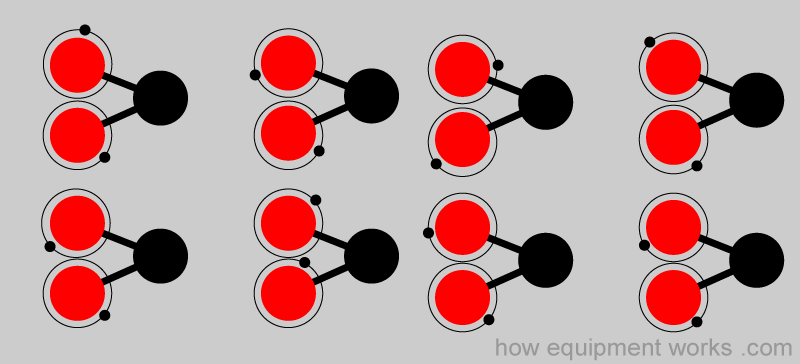
It only sees the hydrogen nuclei contained in water molecules (Note: plural of nucleus is “nuclei “).
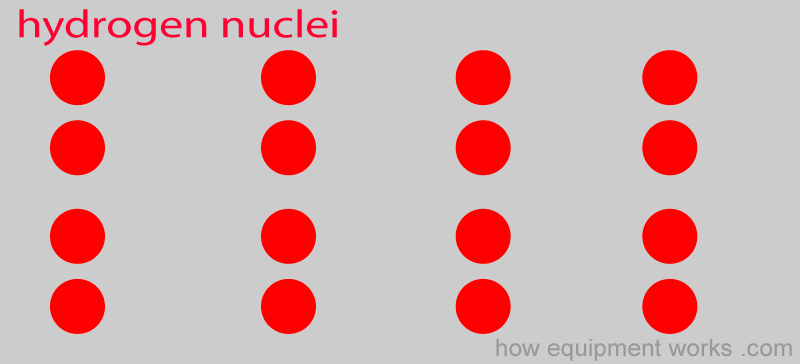
The MRI machine uses certain properties of these hydrogen nuclei to compose an image for you to see. The concepts it uses to do this can be a little complex, but if we approach it in a step-by-step manner, we will eventually understand the basics.
The strange world of quantum physics and spin
At this point, I need to warn you that you will soon be introduced to some very strange physics phenomena.
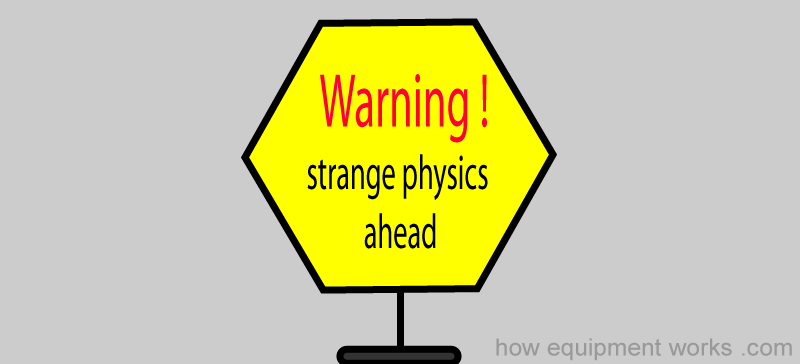
Physics can be divided into two categories called ‘classical physics’ and ‘quantum physics’. Classical physics deals with ordinary everyday objects that you and I can see. For example, classical physics can easily explain how a ball bounces on a floor.
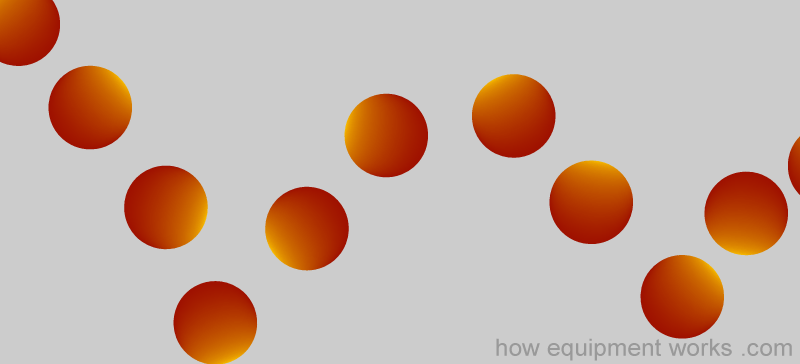
On the other hand, the branch of physics called “quantum physics” deals with much smaller things. When I say small, I mean things that are extremely small such as atoms and electrons. At this level, the rules of classical physics that we are used to, seem to “break down”. Instead, extremely small particles such as atoms obey the very weird rules of quantum physics. For example, in the world of quantum physics, an electron can be at “two places” at the same time! An electron can be sipping some coffee in New York, in the USA, and at the very same time, can be sipping tea in New Delhi, India. Okay, the tea and coffee part is not true, but the being at two places simultaneously is true. (If you do not believe me, search for “double slit experiment ” on the internet to find out more) .
What I am trying to say is that quantum physics is weird and I recommend, for your sanity, that you don’t try to understand it too deeply. Unfortunately, MRI machines deal with very tiny particles (i.e. hydrogen nuclei) and therefore they follow the rules of quantum physics. It is difficult to ‘imagine’ quantum physics because often there is nothing in our everyday life that behaves like it.
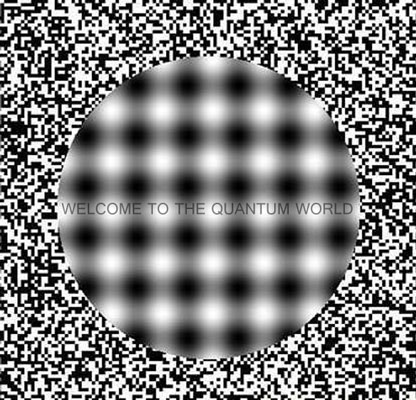

I am the author of this website. Let me tell you about another website I created that you may like. I am interested in psychology, especially how one’s thinking can affect one’s happiness. I have made a website that explains a concept called “Happy Thinking”, which is about how one can find happiness by changing one’s way of thinking. Happy Thinking is an easy-to-understand concept that you can use in daily life to be happier. You can learn about it on the free website at the link below.

Now let us return to discussing the MRI machine. You will recall that we said that MRI machines can “see” hydrogen nuclei contained in water molecules.
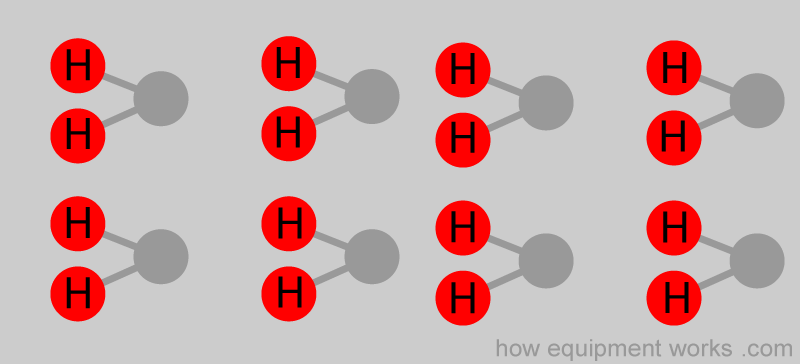
Hydrogen nuclei have a quantum physics property called “spin “. Now you probably imagine hydrogen nuclei “spin” to look something like this.

Unfortunately, as mentioned before, in quantum physics things are weird. In quantum physics terms, “spin” doesn’t mean going round and round. Instead, it is a much more complex property that is difficult to describe. So, like many things in quantum physics, it is best to accept certain things, instead of getting grey hairs trying to understand it. So accept that, according to the laws of quantum physics, hydrogen nuclei have a property called spin, which can be ‘oriented’ in certain ways.

You may wonder why scientists use a word like ‘spin’ to describe something that doesn’t actually spin. The answer to that I do not know. However, I can tell you that quantum scientists like to use strange names to describe things. For example, there are particles in nature called ‘Quarks’. There are six known types of Quarks, and here are their official names ( I am not joking):
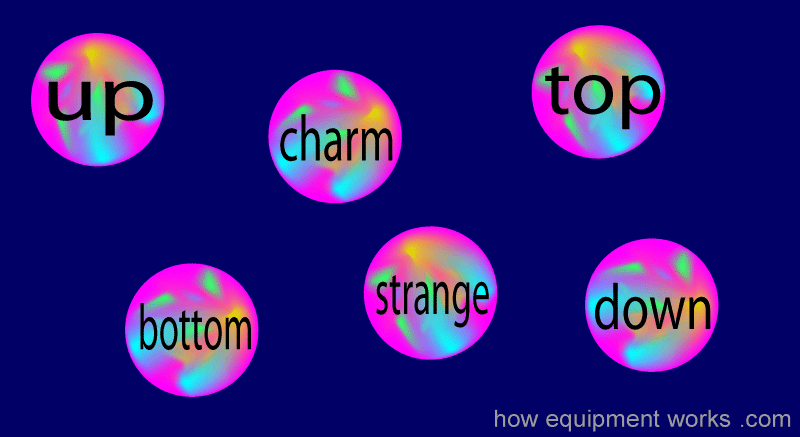
So you see, having a strange name like ‘spin’ to describe a property of hydrogen nuclei is not unique. For a moment, let us put this spin story away. ( Don’t worry, we will come back to it later).
Detection of hydrogen nuclei
We are now ready to start understanding how the MRI machine works. The MRI machine cannot just simply “see the hydrogen nuclei which lie “hidden” in the water molecules distributed in the patient.
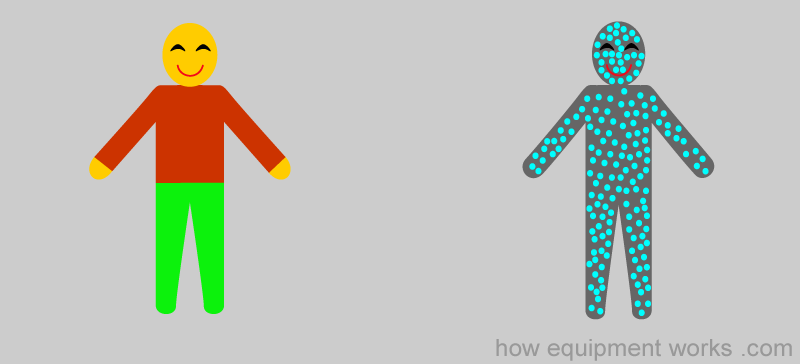
It needs to do ‘something’ to the hydrogen nuclei to detect their presence. It is a bit like the scenario I will describe to you. Just imagine that we have three grumpy men.

The three grumpy men are now sleeping in this black room. Let us imagine that you have to work out where each of the three men are. But looking at the room, you really can’t make out where they are since it is completely dark.

One way to work out where the three men are is to “irritate them “. You send some “energy “ across the room in the form of you shouting “wake up “ repeatedly.
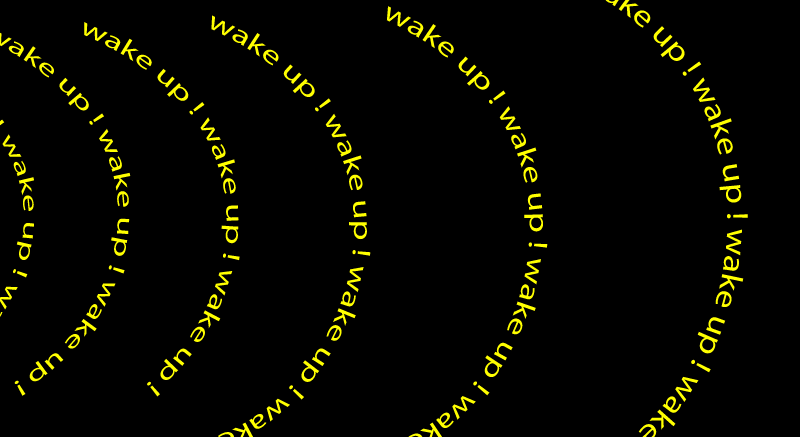
This will agitate the men and they will shout back at you. By working out from where their voices are coming, you can identify where the three men are.
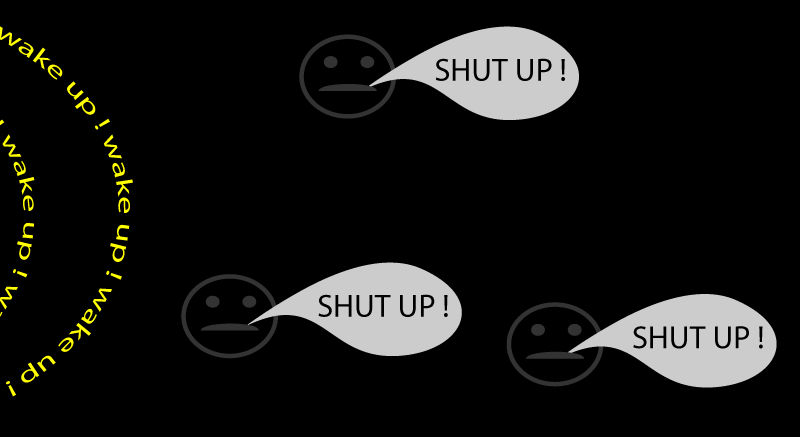
The MRI machine does something similar to detect the hydrogen nuclei. It first “irritates “ the hydrogen nuclei and then from their “responses”, detects their presence. How the MRI machine does this is somewhat more complicated than shouting to detect three grumpy men, but don’t worry, I will explain it to you.
Magnetic resonance imaging, as the name implies, makes use of a magnet. So let us start by giving our MRI machine a strong magnet. In the highly simplified diagram of an MRI machine drawn below, the magnet is shown as the green coils of wire. The magnetic fields produced by the magnet are represented by the green lines with arrows. This magnetic field is continuously present and in our example, goes from the top to the bottom (direction of arrows).
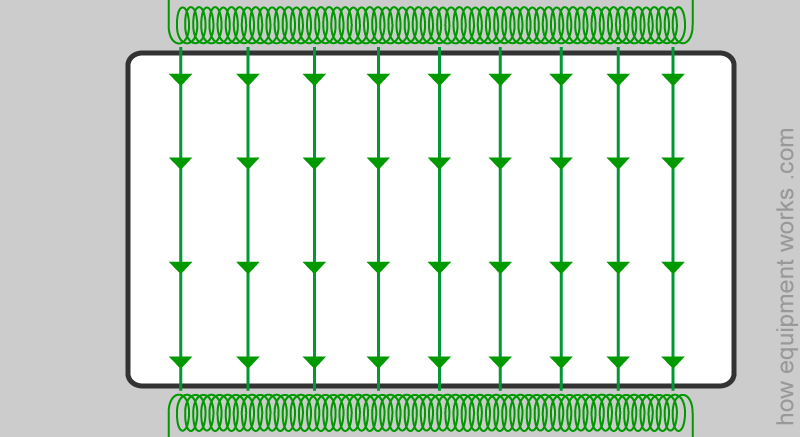
We now put the patient into the magnetic field of the MRI machine.
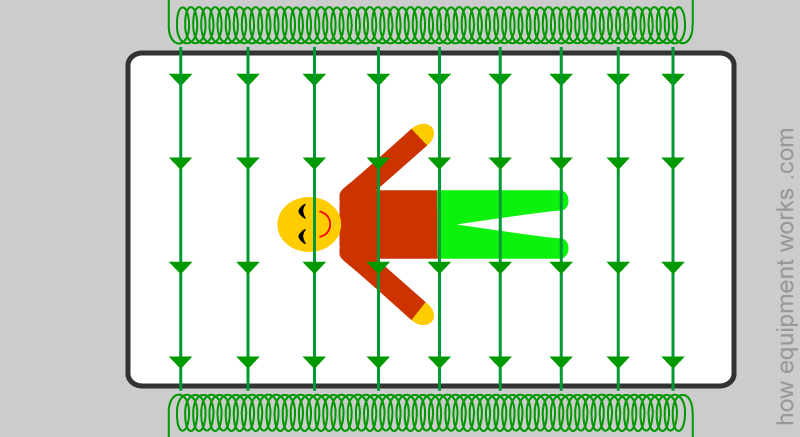
The patient, like all of us, has water molecules distributed all over. As described before, the water molecules have hydrogen nuclei, and this is what is of interest to the MRI machine.
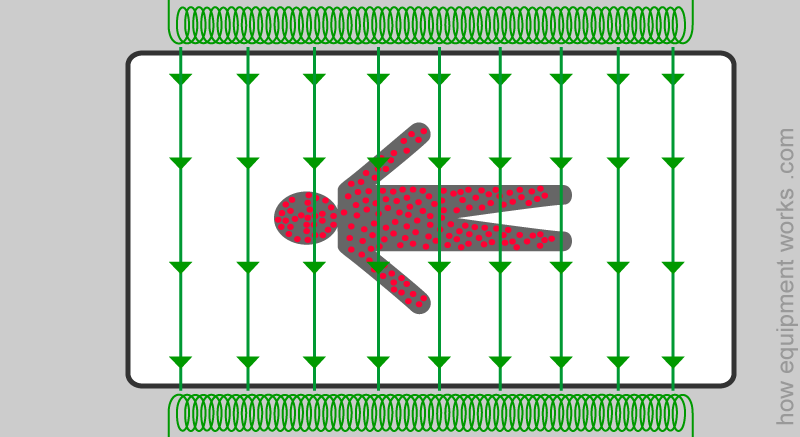
To make the diagrams clearer, I will no longer draw the patient. Instead, I will only show the hydrogen nuclei that are inside him.
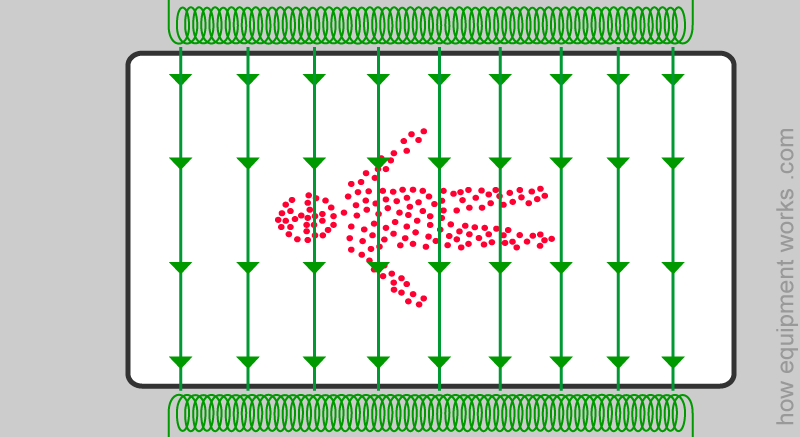
To further make the diagrams clearer, I will be showing a close-up of only a few of the hydrogen nuclei.
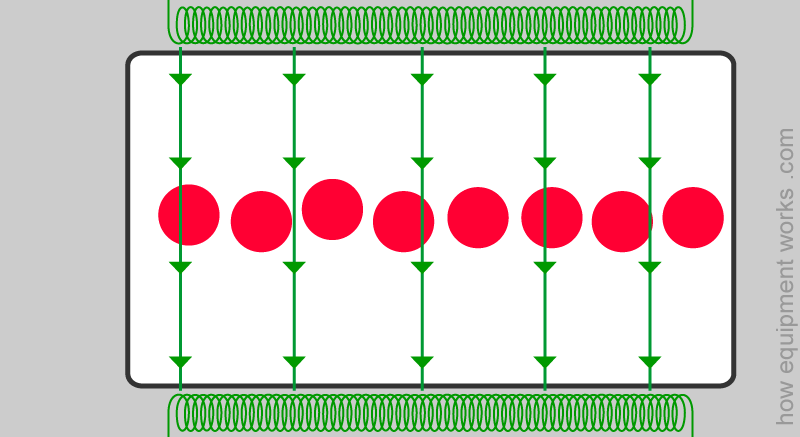
You will recall that due to the weird laws of quantum mechanics, hydrogen nuclei have a property called ‘spin’. The spin can be ‘oriented’ in certain ways.
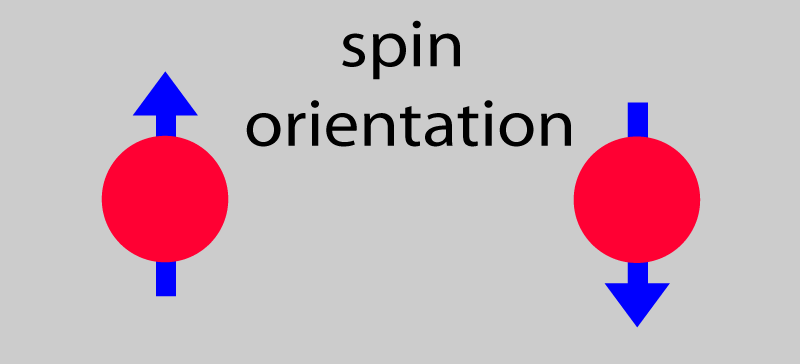
The magnetic field does something interesting to the spins of the hydrogen nuclei. In our example shown below, the magnetic field (green lines) goes from the top to the bottom. The strong magnetic field makes the spins (blue arrows) of the hydrogen nuclei line up along the magnetic field. Some of the hydrogen nuclei line up in the direction of the magnetic field (lower nuclei in the diagram) and other hydrogen nuclei line up opposite to the direction of the magnetic field (upper nuclei in the diagram).
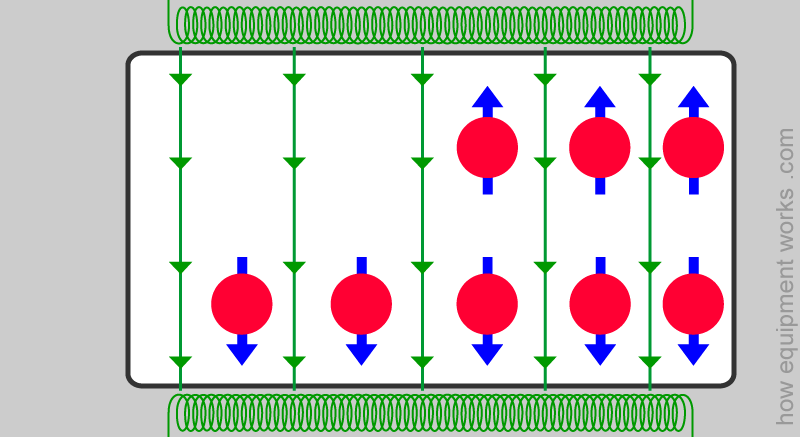
As mentioned before, the spins of some hydrogen nuclei are in the same direction as the magnetic field. Since these nuclei choose to be in the same direction as the magnetic field, they do not need much energy (you can think of them to be the “lazy” ones). In our diagrams, as shown below, I will label these “low energy nuclei” as “Low”.
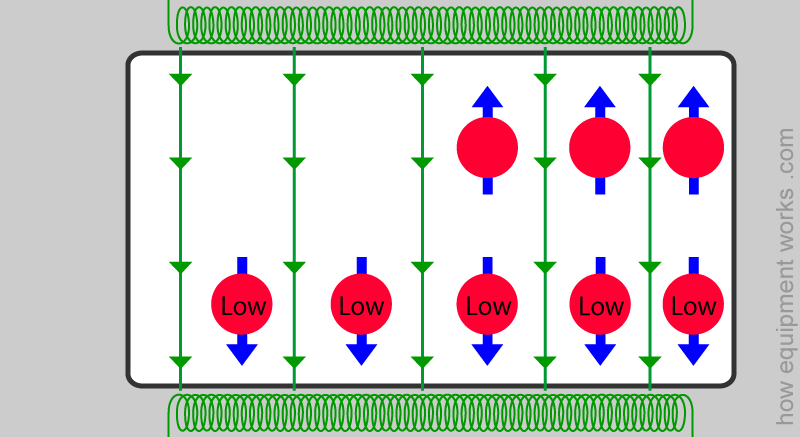
There are also some hydrogen nuclei that have spins that are in the opposite direction to the magnetic field. Unlike the lazy nuclei you saw before, these ones have to “fight” the magnetic field and therefore have “higher” energy. In our diagrams, as shown below, I will label these “high energy nuclei” as “High”.
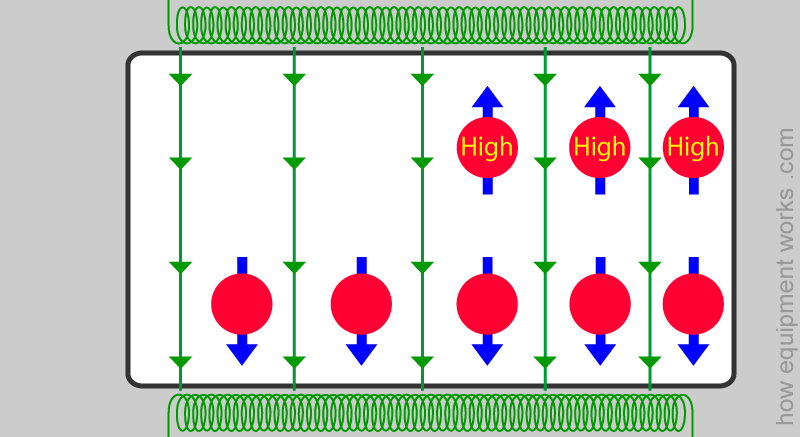
After the magnetic field has made the nuclear spins line up, you will notice that there are slightly more low-energy nuclei than high-energy nuclei. I suppose hydrogen nuclei are like humans: there are more lazy ones than active ones!
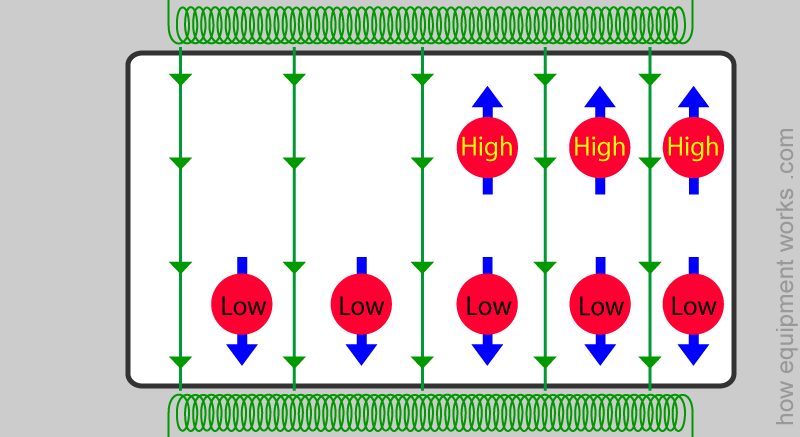
This slight excess of low-energy hydrogen nuclei is extremely important. As you will see soon, it is the behaviour of these low-energy hydrogen nuclei that make MRI possible.
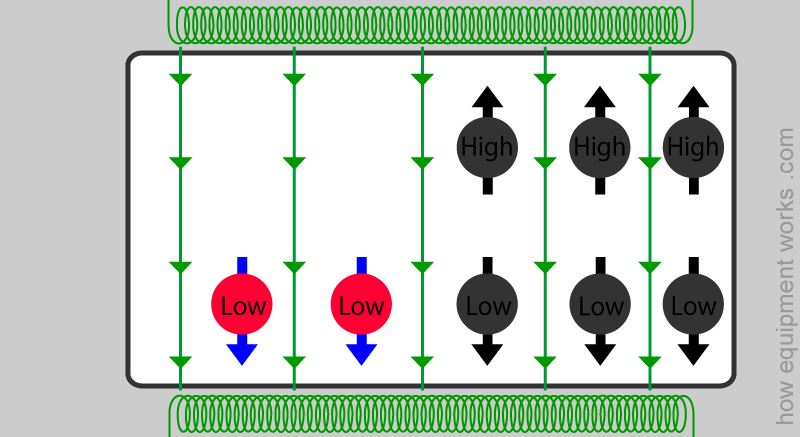
Do you remember our story about finding the three grumpy men by irritating them?
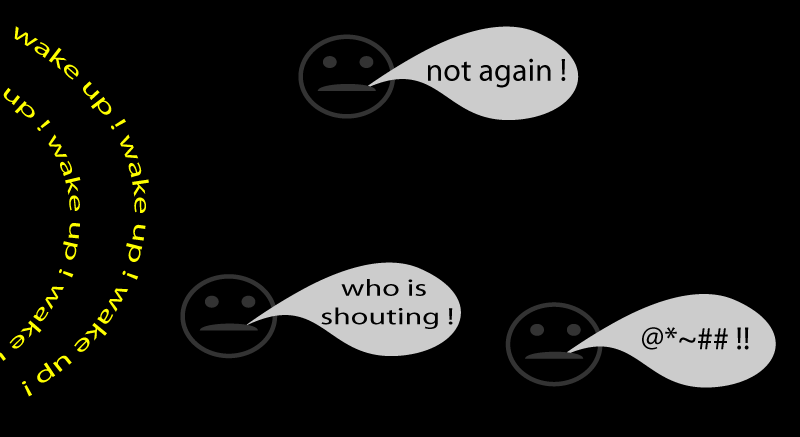
As mentioned, the MRI machine does something similar. However, instead of ‘shouting’ things, it uses ‘energy’ to ‘irritate’ the low-energy hydrogen nuclei. Let us see how the MRI machine does this.
The MRI machine has a special coil of wire that is there for the purpose of producing the needed energy to ‘irritate’ the low-energy hydrogen nuclei. In the diagram below, this coil is shown in black, on the left side.
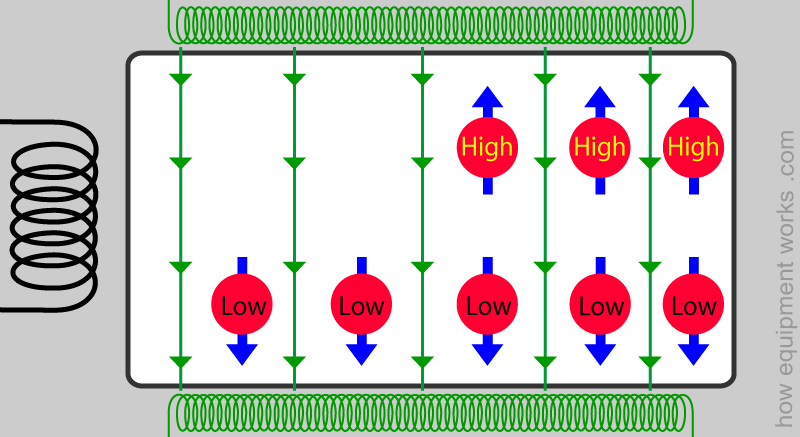
The MRI machine applies a current to this energy-producing coil for a short period. During this period, the coil produces energy in the form of a rapidly changing magnetic field (pink waves in the diagram below). The frequency (i.e. how often it changes in one second) of this changing field falls within the frequency range commonly used in radio broadcasts. Therefore this energy is often called “radio frequency” energy (RF energy) and the coil is often called a radio frequency coil ( RF coil).
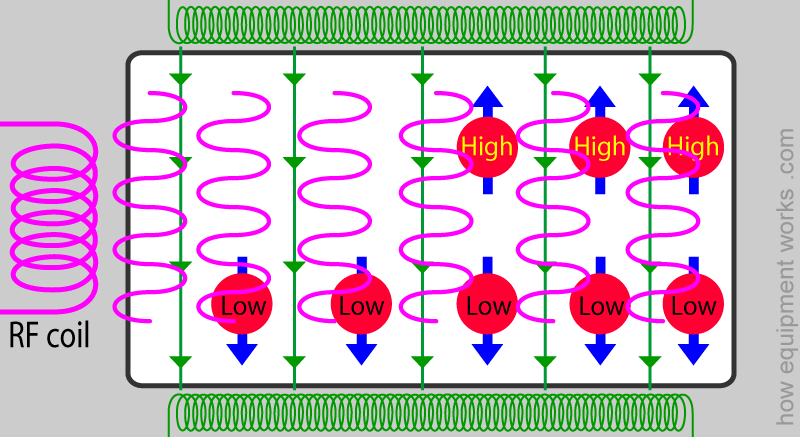
Now something fascinating happens to the hydrogen nuclei with low energy. These hydrogen nuclei with low energy absorb the energy sent from the RF coil.
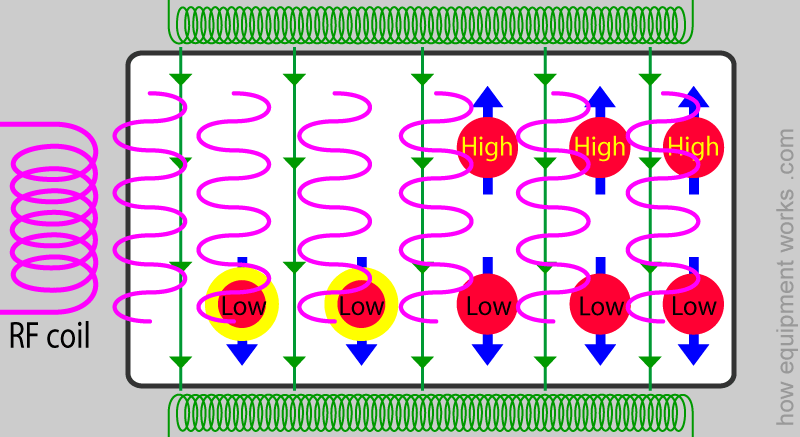
The absorption of RF energy changes the energy state of the low-energy hydrogen nuclei. Once the low-energy nuclei absorb the energy, they change their spin direction and become high-energy nuclei.
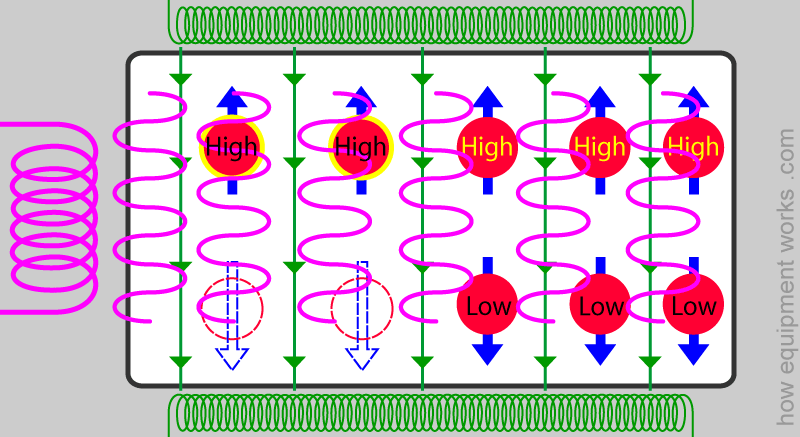
After a short period, the RF energy is stopped.
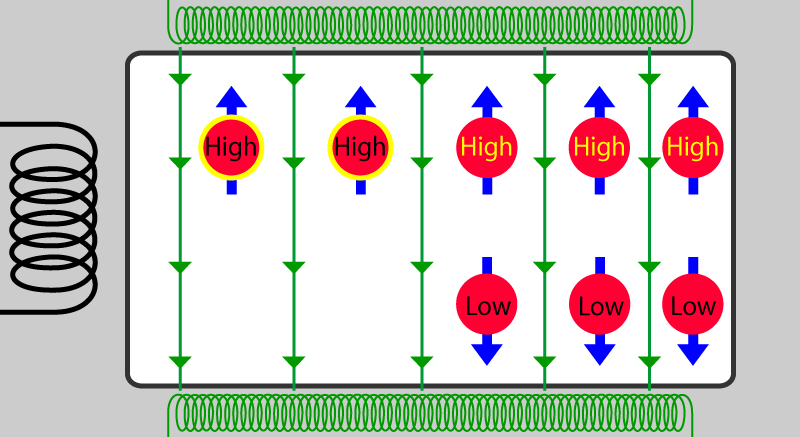
The hydrogen nuclei that recently became ‘high energy’ prefer to go back to their previous, ‘low energy’ state and they start releasing the energy that was given to them (i.e. the previously lazy nuclei want to be lazy again !). They release the energy in the form of waves, which in the diagram below, is shown in red.
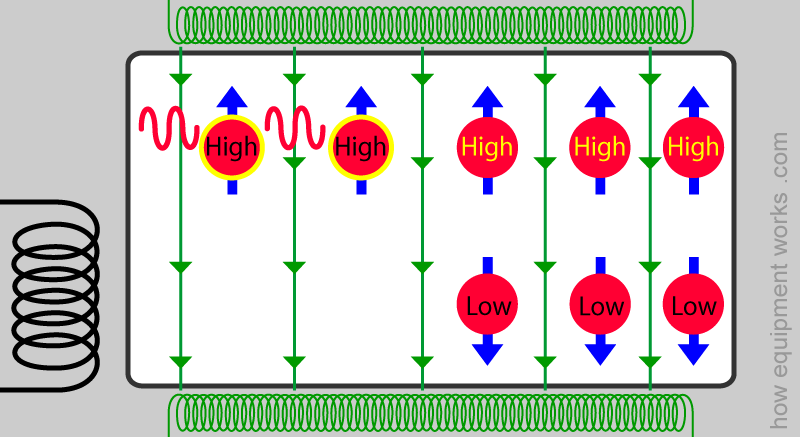
The MRI machine has “receiver coils ” (blue coil shown below) that receive the energy waves sent out by the nuclei. Having given up their energy, the nuclei change their spin direction and return to the low-energy state that they were in before.
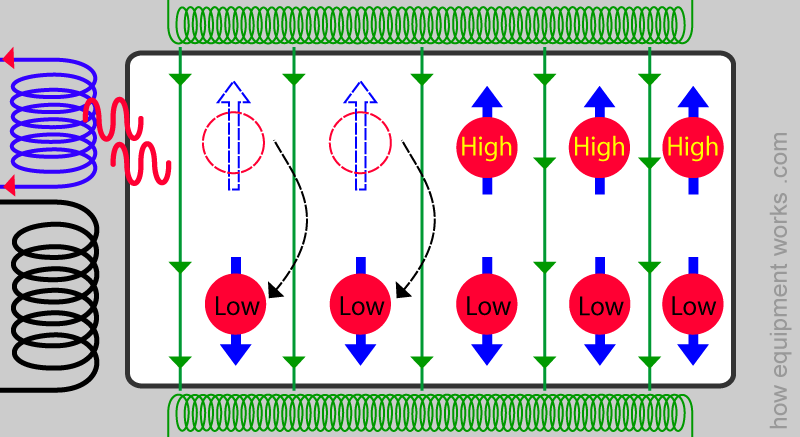
The receiver coil converts the energy waves into an electrical current signal. In this way, the MRI machine is able to detect hydrogen nuclei in the body.
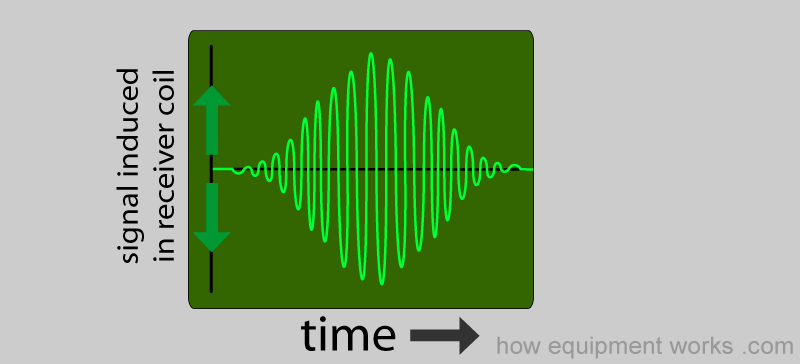
Below is a basic animation that summarizes the sequence the MRI machine uses to give energy and then receive signals from hydrogen nuclei in water molecules. (My animation skills are nearly zero, so please forgive the rather jerky images).

Please click the “Next” button below to read part 2 about how MRI machines work. Thank you.